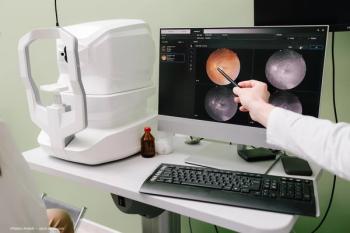
Retinal microvasculature on OCTA may predict coronary artery disease risk
Key Takeaways
- Retinal microvasculature parameters may indicate coronary artery stenosis, offering a noninvasive cardiovascular risk assessment method.
- Optical coherence tomography angiography (OCTA) shows promise as a noninvasive screening tool for coronary heart disease.
Investigators from Austria reported that retinal microvasculature parameters, such as perfusion density (PD) and fractal dimension (FD), may point to the presence of coronary artery stenosis (CAS). They also found that
Maximilian Pawloff, MD, first author of the study, is from the Laboratory for Ophthalmic Image Analysis, Department of Ophthalmology and Optometry, Medical University of Vienna, Vienna. He and his colleagues reported their findings in the Canadian Journal of Ophthalmology.
Currently, coronary angiography (CA) is the gold standard for diagnosing and treating cardiovascular disease (CVD) caused by CAS, a leading cause of worldwide morbidity and mortality.2 A downside to this technology is that it is invasive and requires catheter insertion into coronary arteries, which can cause bleeding, vessel damage, and allergic reactions to contrast agent; CA is also expensive and not universally available, both of which limit its widespread use as a primary screening tool.3 Statistics indicate that 40% of patients undergoing CA have significant CAS, suggesting an opportunity for improved patient selection and risk stratification before CA, according4 to Pawloff and colleagues.
They explained that interest is growing in developing complementary noninvasive approaches that might enhance patient selection for CA, potentially optimizing its therapeutic impact while minimizing unnecessary procedures. “Attention has turned to the examination of retinal vessels as a potential avenue for microvascular analysis. These vessels, reflective of changes in the systemic microcirculation, offer insights into the intricate dynamics of microvascular alterations associated with CAS, providing a less invasive and potentially informative path for clinical investigation. Retinal microcirculatory changes have been linked to cardiovascular modifications, but current studies primarily rely on fundus photography, limiting the depth and accuracy of analysis,5-7” they said.
The researchers conducted a cross-sectional exploratory study in which they assessed changes in retinal perfusion and microvascular architecture associated with CAS due to coronary heart disease (CHD) with the goal of establishing OCTA as a noninvasive screening tool for CHD.
They hypothesized that quantitative OCTA microvascular data might serve as a robust proxy for the cardiovascular risk profile. In this study, they evaluated changes associated with CAS by analyzing retinal microvascular parameters on en-face OCTA images, ie, the PD and FD in the superficial vascular plexus (SVP) and deep vascular plexus (DVP).
The study included 982 eyes of 512 patients who underwent CA due to suspected CHD. All patients underwent OCTA to quantify the PD and FD in the SVD and DVP in 1-, 3-, and 6-mm rings placed over the macula and optic nerve head (ONH).
OCTA results
In the superficial retinal plexus, imaging identified significant negative associations between cardiac stenosis and the retinal PD (p = 0.0091) and (FD) (p = 0.0014) in the inner ring and in the deep plexus (PD: p = 0.047; FD: p = 0.013).
In the outer ring, the mean PD and FD were lower in the left eye compared to the right eye (PD, superficial: p < 0.0001, deep: p < 0.0001; FD, superficial: p < 0.0001, deep: p = 0.0012). No significant associations were found in the ONH.
They explained that the results suggested that the retinal microvascular parameters may serve as indicators of the presence of stenosis, especially in specific retinal regions and layers, and provide insights into potential noninvasive methods for cardiovascular risk assessment.
“Our study provided valuable insights into a common association between retinal microvascular changes and stenosis, highlighting the potential use of OCTA-based retinal imaging as a noninvasive tool for cardiovascular risk stratification. Future research should focus on elucidating the underlying mechanisms driving these associations, exploring the clinical implications of retinal microvascular analysis, and the development of sensitive artificial intelligence-based image analysis approaches for CHD management and prevention,” Pawloff and colleagues concluded.
References
Pawloff M, Jeremic N, Zarghami A, et al. Biomarkers of microvascular retinal perfusion in OCTA indicative of coronary heart disease. Can J Ophthalmol. 2025; published online July 23. DOI:
10.1016/j.jcjo.2025.06.022 Tsao CW, Aday AW, Almarzooq ZI, et al. Heart disease and stroke statistics - 2023 update: a report from the American Heart Association. Circulation. 2023;147:E93–E621.
Virani SS, Newby LK, Arnold SV, et al. 2023 AHA/ACC/ ACCP/ASPC/NLA/PCNA Guideline for the management of patients with chronic coronary disease: a report of the American Heart Association/American College of Cardiology Joint Committee on Clinical Practice Guidelines. Circulation. 2023;148:E9–E119.
Albus C, Barkhausen J, Fleck E, Haasenritter J, Lindner O, Silber S. The diagnosis of chronic coronary heart disease. Dtsch Arztebl Int. 2017;114:712–9.
Cheung N, Bluemke DA, Klein R, et al. Retinal arteriolar narrowing and left ventricular remodeling. The multi-ethnic study of atherosclerosis. J Am Coll Cardiol. 2007;50:48–55.
Rizzoni D, Muiesan ML. Retinal vascular caliber and the development of hypertension: a meta-analysis of individual participant data. J Hypertens. 2014;32:225–7.
Wang JJ, Liew G, Klein R, et al. Retinal vessel diameter and cardiovascular mortality: pooled data analysis from two older populations. Eur Heart J. 2007;28:1984–92.
Newsletter
Don’t miss out—get Ophthalmology Times updates on the latest clinical advancements and expert interviews, straight to your inbox.













































